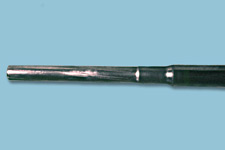- 01: Introduction
- 02: History
- 03: Propellants, Firearms, and Ammunition Development
- 04: Modern Firearms Manufacture
- 05: Small Arms Ammunition
- 06: Evidence Handling Procedures
- 07: Equipment and Instrumentation
- 08: Examination of Firearms
- 09: Cartridge and Shotshell Examination
- 10: Characterization and Evaluation of Fired Projectiles
- 11: Bullet Comparison and Identification
- 12: Gunshot Residue and Distance Determination
- 13: Toolmark Identification
- 14: Communicating Results
- Resources


Hammer Forged
Home > Modern Firearms Manufacture > Rifled Barrels > Hammer Forged

Mandrel with reverse rifling
Click for larger imageHammer forging is an equipment intensive but efficient method for making rifled gun barrels. Hammer-forged rifling starts with a reusable mandrel that carries the reverse image the entire length of the bore and uses it to produce the desired rifling profile. The lands and grooves are visible in reverse, spiraling the full length.
Other rifling methods start with drilling a hole slightly smaller than the desired minimum bore diameter and with the barrel blank at or above the finished length.
Barrels headed for the hammer forge-rifling machine begin as any other barrel, with two exceptions:
- The deep-drilling operation leaves the bore slightly larger than the desired maximum diameter of the finished bore to accept the mandrel.
- The barrel length is shorter than the finished barrel; the forging operation elongates the tube.
A blank is clamped in a rotating holder. The rotation is not used to produce the rifling twist in a hammer-forged barrel; the twist is in the mandrel. Rotation is used to keep the barrel round during the forging operation. The mandrel is inserted into the borehole, and the barrel moves at a constant speed toward a series of cam-driven hammers arranged in a circle. Hammers are paired 180 degrees apart to equalize stresses. The hammers strike the rotating barrel with tremendous force, bending the steel to contact the mandrel inside.
The following settings affect the equal compression of barrel parts:
- Rate of feeding the barrel into the hammers
- Rate of rotation
- Frequency of hammer strikes
After forging, the barrel is longer. The external surface exhibits small peening marks from thousands of overlapping hammer strikes. These are usually removed in final barrel profiling. Steel is somewhat elastic and springs away from the mandrel after the force is removed. This facilitates withdrawing the mandrel, which is reused for the next barrel.
Some military and commercial armories take barrel forging a step further. If the barrel requires an integral chamber to support the cartridge, as do most firearms other than revolvers, the rough chamber can be formed in the barrel forging process. If the process uses a full-length mandrel, the rough shape of the chamber can be machined on the mandrel and a significant amount of cutting is eliminated to complete the chamber.
Hammer forging produces a very straight barrel with a work-hardened bore surface. Marks of interest to the firearm examiner consist almost entirely of drill and reamer marks from upstream operations and any marks resulting from chambering and crowning operations.




